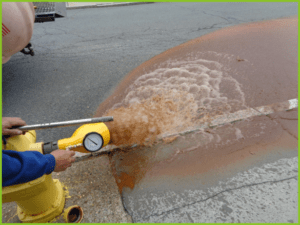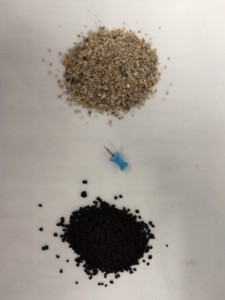Moving Northeast Water Treatment Forward
Utilizing Biological Filtration to Ensure Clean Drinking Water
Derek Belanger, PE
John McClellan, PhD, PE
Louis Soracco, PE
Groundwater is a large source of drinking water throughout the world and is an important resource for the Northeast. Tighe & Bond has been working with communities to treat issues from iron and manganese in groundwater for many years. Iron and manganese, being abundant elements in the earth, are commonly found in soil and can dissolve into groundwater used in community drinking water sources. Iron and manganese dissolved in water become oxidized when exposed to air or oxidant chemicals, such as chlorine, and precipitate either within a water distribution system or in your own home.
Signs iron and manganese could be impacting your drinking water

Rusty and cloudy water due to elevated iron and manganese levels.
If potable water contains high iron and manganese levels, it can appear hard, rusty or cloudy, stain household fixtures, or have a metallic taste. These aesthetic concerns are regulated by the U.S. EPA as Secondary Maximum Contaminant Levels (SMCLs). Iron and Manganese SMCLs set by the US EPA are 0.3 mg/L and 0.05 mg/L respectively. Although iron and manganese are essential nutrients, manganese may be harmful at high concentrations and over long periods of exposure. Some states, such as Massachusetts and Connecticut, have set regulatory guidelines, or Action Levels (ALs), for manganese at 0.3 mg/L; which are consistent with the U.S. EPA’s lifetime health advisory limit. Both the health and aesthetics issues can be concerning for water professionals and the public. The image of “dirty” water coming from a faucet ultimately reduces faith in the safety of the water and will likely compromise the public trust of the water system if not corrected.
Typically, if a water system is receiving “dirty” water complaints, particularly during high demands or after water main breaks, it means that the source has contributed to sediment buildup throughout the distribution system. This can be caused by the source of the water, or well, pumping iron and manganese into the distribution system where it settles and causes the “dirty” water and its associated aesthetic concerns to appear when flows are high. The first step towards solving this issue is to remove the problem at the source and prevent the buildup in the distribution system. It is in this way a water system can continue to flush out the “dirty” water, and have clean water take its place.
Strategies professionals use for iron and manganese treatment
There are two basic strategies for treating water with high iron or manganese concentrations:
Sequestration – The first is sequestration, which consists of adding a polyphosphate chemical to interact with the metal ions, thereby inhibiting precipitation. Sequestration doesn’t actually remove the iron or manganese, but it can be effective in reducing the negative effects, and it is inexpensive compared to other methods. The caveat to this treatment is that sequestration becomes less effective in hot water and as the metal concentration increases.
Iron and Manganese Removal – The other strategy consists of removing the iron and manganese from the water. Processes typically used to remove these constituents include a combination of oxidation, adsorption, filtration, or settling.
The chemical oxidation process is the most common in municipal water treatment applications and uses an oxidant such as chlorine or permanganate to convert soluble metal ions into insoluble precipitate that can then be removed from the water by filtration or settling.
Recently, New England communities have been investigating the feasibility of using bacteria instead of chemicals to assist in removing iron and manganese from groundwater; this is known as biological filtration. Tighe & Bond engineers are leaders in the investigation and implementation of this innovative technology for water treatment plants, helping to design three of the four full-scale biological filtration systems currently operating in New England.
Applying the Biological Process for Removing Iron and Manganese
Our experts can help communities understand the biological iron and manganese removal process and whether it is the right technology for their application. Microorganisms that oxidize iron and manganese are naturally occurring and can be found in groundwater sources throughout the world. Biological filtration harnesses the ability of these naturally occurring bacteria to remove iron and manganese from groundwater. These bacteria are ubiquitous and have evolved over millions of years to survive in waters where dissolved iron and manganese are present. Unlike traditional iron and manganese removal systems, these bacteria take the place of a chemical oxidant.

An example of virgin and mature media. Courtesy of Blueleaf Inc.
For water professionals to harness the power of these microorganisms, they create the proper environment for the naturally occurring iron- and manganese-oxidizing bacteria to thrive. This is typically accomplished by striking a delicate balance with pH, oxidation-reduction potential (ORP), and dissolved oxygen (DO) in the groundwater. With the correct conditions, these bacteria will grow into a biofilm on the surface of a filtration media, typically sand. Different bacteria cultures are required for each of the metals. In locations where both iron and manganese are present in the water, the process requires two stages, with conditions favorable to iron oxidizing bacteria maintained in one, and conditions favorable to manganese oxidizing bacteria maintained in the other.
These bacteria act as catalysts, oxidizing the iron or manganese, under the correct conditions. The time required for the initial establishment of the bacterial colony is referred to as the “seeding time”. The seeding time is the time it takes for a biological filter to establish a robust biofilm on the media surface. The amount of seeding time depends on the raw water quality, temperature, and other factors, but can be reduced by introducing a small amount of filter media or backwash waste from another mature biologically active filter.
Biological Filtration in Practice: Achieving Innovative Solution Milestones
Tighe & Bond professionals provide solutions that allow our clients to perform their duties in the safest, easiest and most economical ways. Our history of biological filtration in practice is a highlight of these core values.
The biological process was first selected for a small water treatment plant in Cavendish, Vermont. The Town had been concerned about the rising iron and manganese concentrations at their groundwater wells. Biological treatment was selected after pilot testing and conducting a lifecycle cost comparison with two chemical oxidation processes and the biological process. Data from the pilot study indicated the biological process had the lowest estimated lifecycle cost, based on lower chemical costs and longer filter runs between backwashes. The difference in the backwashing frequency between the chemical oxidation process and the biological process is striking. The calculated backwash frequency and amount of backwash water produced was an order of magnitude less for the biological process. Longer runtimes translate into fewer backwashes, less time at the plant for the operator, and lower labor costs for operating the plant. In addition, a significant portion of the backwash water reduction is due to biological filtration being a mono-media system, eliminating the need for a high rate backwash re-stratification of the media. This reduction plays a significant role in both capital and operational costs for the life of the facility. The Town’s iron and manganese treatment facility was placed in service in May 2009, marking the first New England facility of its kind to use the biological filtration process.
The biological process was later selected for larger water treatment facilities in Putnam, Connecticut, and Middleborough, Massachusetts. The Town of Putnam’s raw water had minor amounts of iron but high concentrations of manganese. In contrast, the Town of Middleborough’s wellfield had experienced high levels of iron, but only minimal manganese. Pilot testing and a lifecycle cost analyses comparing two chemical oxidation processes to the biological process was conducted at both facilities. The results made it clear that the biological process offered significant advantages to the communities of Putnam and Middleborough.
On November 28, 2018, the Town of Putnam received Connecticut Department of Public Health (CTDPH) approval to operate the Park Street Wellfield Treatment Facility. This facility became the first in Connecticut to use the biological filtration process. Less than a month later, the Town of Middleborough received Massachusetts Department of Environmental Protection (MassDEP) approval for the East Main Street Treatment Plant to be placed into operation as the first biological iron filtration system in Massachusetts.
Biological treatment for iron and manganese removal from groundwater has shown promise in many communities and Tighe & Bond continues to work with clients throughout New England to investigate its effectiveness. Our experts approach each project by assessing all water treatment options because the water quality and objectives at every site are different. Whether we recommend biological filtration, sequestration, or other treatment options, our continued investigation into new technologies is advancing options for drinking water professionals throughout the Northeast.
Tags: biological filtration, drinking water, iron, manganese


